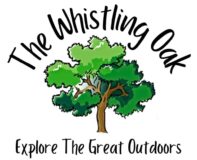Discover 14 Animals in Mammoth Lakes during scenic hikes, with essential viewing tips and hotspots.
Get ready to meet the locals of Mammoth Lakes—no, not the people, the animals! This corner of the Eastern Sierra is a real-life nature channel, where you might bump into black bears (don’t worry, they’re more camera-shy than you’d think), or lock eyes with a majestic mountain lion.
Whether you’re by the lakes, in the forests, or up on the peaks, wildlife encounters here are as common as stunning views.
We’re taking you on a trek to track down 14 incredible creatures that call Mammoth Lakes home. From the stealthy mule deer and the soaring bald eagles to the tiny, yet mighty, rubber boas. Plus, we’ll show you where to find them and how to watch them without turning into a bear’s brunch.
So lace up those hiking boots, charge your camera, and let’s go wildlife spotting. Remember, these animals aren’t just amazing photo ops—they’re part of what makes Mammoth Lakes the wild wonder that it is. Ready to explore?
Black bears
The black bear, emblematic of the Sierras, is an awe-inspiring sight against the backdrop of Mammoth Lakes. Donning fur colors that span from jet black to cinnamon and even blonde, they seamlessly blend into the dense forests and rugged terrains.
A visit to wilderness areas such as Ansel Adams Wilderness and Inyo National Forest often presents an opportunity to observe these magnificent creatures in their natural abode.
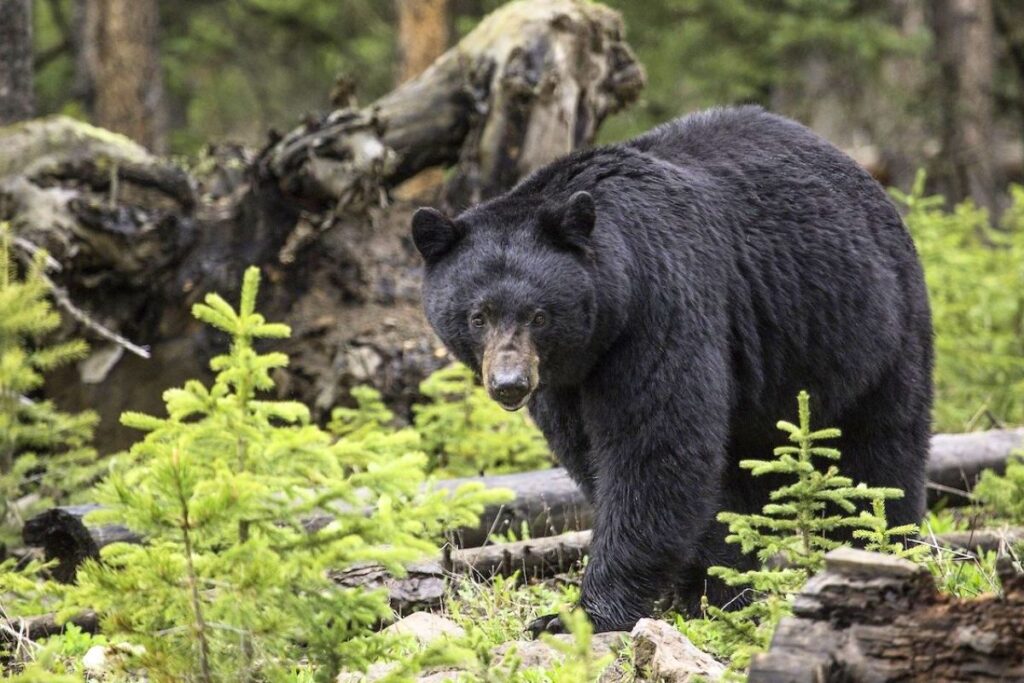
For trekkers planning their routes, the Duck Pass Trail and Crystal Lake Trail are particularly rewarding.
Setting out during early mornings or evenings heightens the chance of a serene bear encounter. But remember, their calm demeanor shouldn’t be mistaken for tameness.
Always ensure a safe distance, refrain from feeding them, and practice caution, especially in campgrounds like Coldwater Campground and Sherwin Creek Campground where bear activity is known.
A noteworthy fact for travelers: these black bears possess an extraordinary sense of smell, magnitudes stronger than a bloodhound’s.
This keen olfactory ability makes them proficient food trackers, reinforcing the importance for campers to store food securely.
When planning a Mammoth Lakes adventure, the prospect of witnessing a black bear amidst the sprawling wilderness is thrilling, but safety – both for visitors and the bears – should always be paramount.
Mule deer
Mule deer, with their distinctive large ears resembling those of a mule, are a graceful sight that exemplifies the serenity of Mammoth Lakes.
Their elegant stature, with a grayish-brown coat in winter that transitions to a reddish-brown in summer, offers a visual treat against the sprawling green landscapes.
For visitors eager to spot these gentle herbivores, the wilderness expanses of Ansel Adams Wilderness and John Muir Wilderness are prime habitats.
Moreover, trails such as Mammoth Crest Trail and Minaret Lake Trail are renowned for mule deer sightings, especially during the tranquil hours of dawn and dusk when they’re most active.
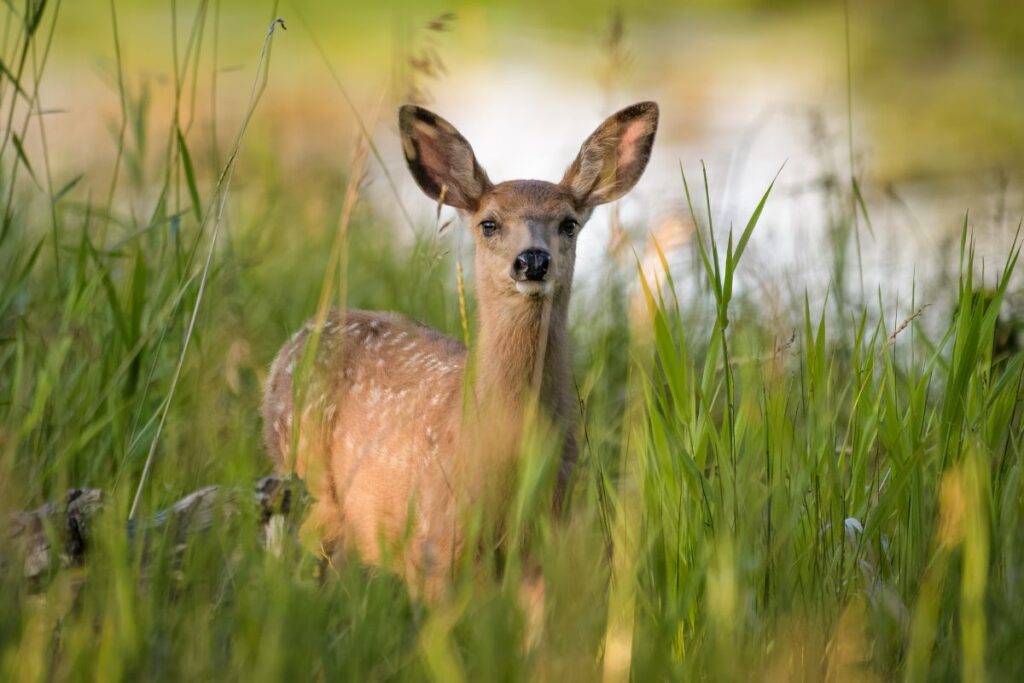
Campers setting up at places like Agnew Meadows Campground and Twin Lakes Campground should be prepared for delightful encounters, as these areas frequently play host to mule deer grazing or passing through.
But as with all wildlife, it’s imperative to observe without interfering or feeding.
An intriguing tidbit for those charting their Mammoth Lakes journey: Mule deer undergo a fascinating migration pattern, often covering vast distances between seasonal ranges. This migration not only showcases their adaptability but also underscores the rich biodiversity of the region.
As you plan your trip, the prospect of observing mule deer in their native terrains adds a touch of enchantment to the Mammoth Lakes experience. Always remember to tread lightly and respect their space.
Mountain lions
The elusive mountain lion, also known as the cougar or puma, is one of the apex predators of Mammoth Lakes, commanding respect and awe for its sheer power and grace.
With a sleek, tawny coat and a long, sinuous tail, their presence is often sensed rather than seen, adding a mysterious allure to the Mammoth Lakes wilderness.
For the intrepid explorer, wilderness areas like John Muir Wilderness and Inyo National Forest provide the remote terrains these majestic cats favor.
Hikers on trails such as Convict Lake Loop and Bloody Canyon Trail should be alert, especially during twilight hours, as these are prime times for mountain lion activity.
While sightings are rare given their secretive nature, the thrill of possibly glimpsing one in the wild remains unmatched.
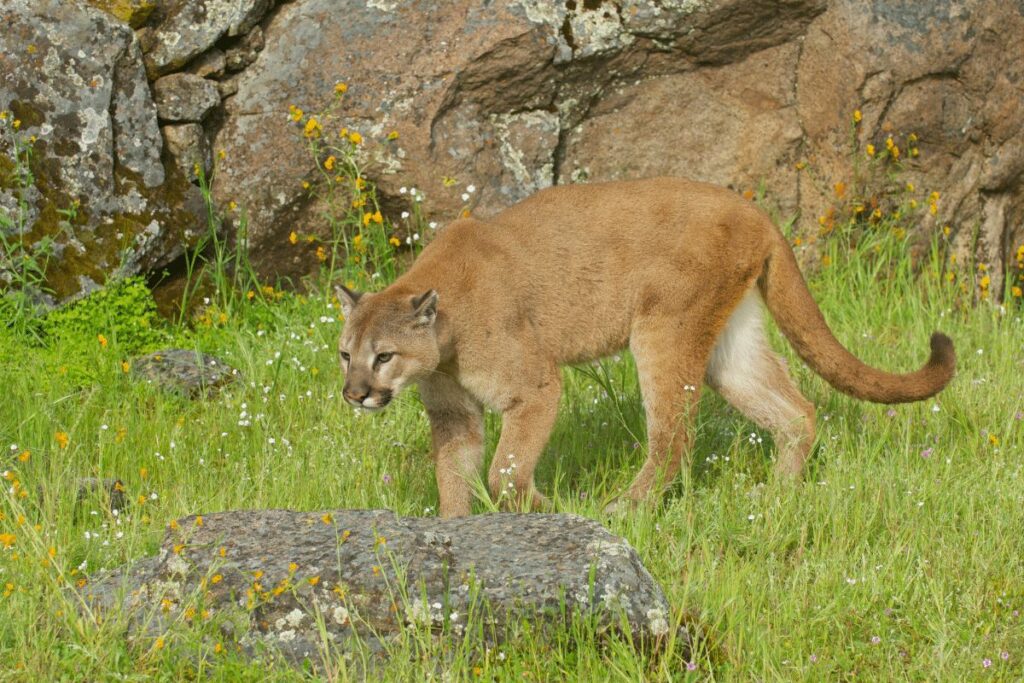
For those camping in more secluded spots, such as Big Springs Campground and Sawmill Walk-in Campground, it’s essential to be aware of mountain lion safety tips.
This includes making plenty of noise if you encounter one and ensuring children are close, especially during evenings.
An enthralling fact for adventurers planning their Mammoth Lakes itinerary: Mountain lions have territories that can span over a hundred square miles, showcasing their dominance and adaptability in this vast wilderness.
While the idea of spotting a mountain lion is exhilarating, safety and respect for these magnificent creatures are paramount.
Always remember that you’re in their domain, and take every precaution to ensure a harmonious coexistence during your visit.
Bighorn sheep
The Sierra Nevada Bighorn Sheep, with its majestic curved horns and rugged adaptability, stands as a testament to the resilient spirit of Mammoth Lakes’ high country.
Sporting a thick, creamy-colored coat that offers insulation against the harsh alpine conditions, these magnificent creatures are a sight to behold, especially when seen navigating the region’s steep and rocky terrains.
For those hoping to witness the grandeur of these alpine specialists, the high-altitude terrains of Ansel Adams Wilderness and John Muir Wilderness serve as their primary habitats.
Specifically, trails like Mount Dana Trail and Sawmill Pass Trail offer enthusiasts the chance to spot herds grazing or scaling rocky outcrops, particularly during the warmer months when they ascend to higher elevations.
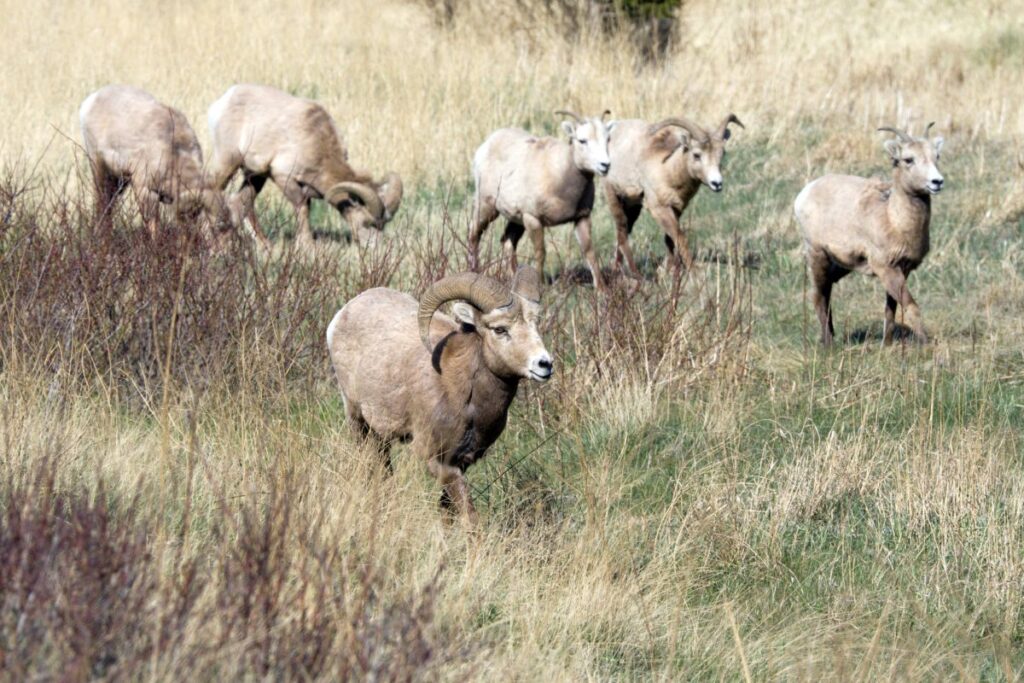
Campers setting up tents in areas such as Outpost Camp or near Trail Crest might be fortunate enough to have these sheep wander into their vicinity, given the proximity to their natural habitats.
However, it’s crucial to appreciate them from a distance and avoid any interference.
For those mapping out their Mammoth Lakes journey, it’s fascinating to note that the Bighorn Sheep’s incredible vision allows them to detect predators from afar and their nimble feet enable them to traverse seemingly impassable terrains.
As you plan your Mammoth Lakes adventure, the possibility of observing Bighorn Sheep in their challenging habitats brings a unique, thrilling dimension to the experience.
Ensure you equip yourself with binoculars and a good zoom lens for the best respectful viewing!
Coyotes
The haunting call of the coyote, echoing amidst the valleys and peaks of Mammoth Lakes, captures the very essence of the wild West.
These adaptable canids, with their tawny fur, sharp eyes, and bushy tails, effortlessly traverse the varied terrains of the region, making them one of the most widespread and versatile predators in North America.
Visitors keen on observing these cunning creatures should turn their attention to open areas within the Mono Basin National Forest Scenic Area and the meadows of Inyo National Forest.
Trails like Sherwin Lakes Trail and June Lake Loop offer promising opportunities, especially during early mornings and evenings, when coyotes are most active, hunting or calling out to their packs.
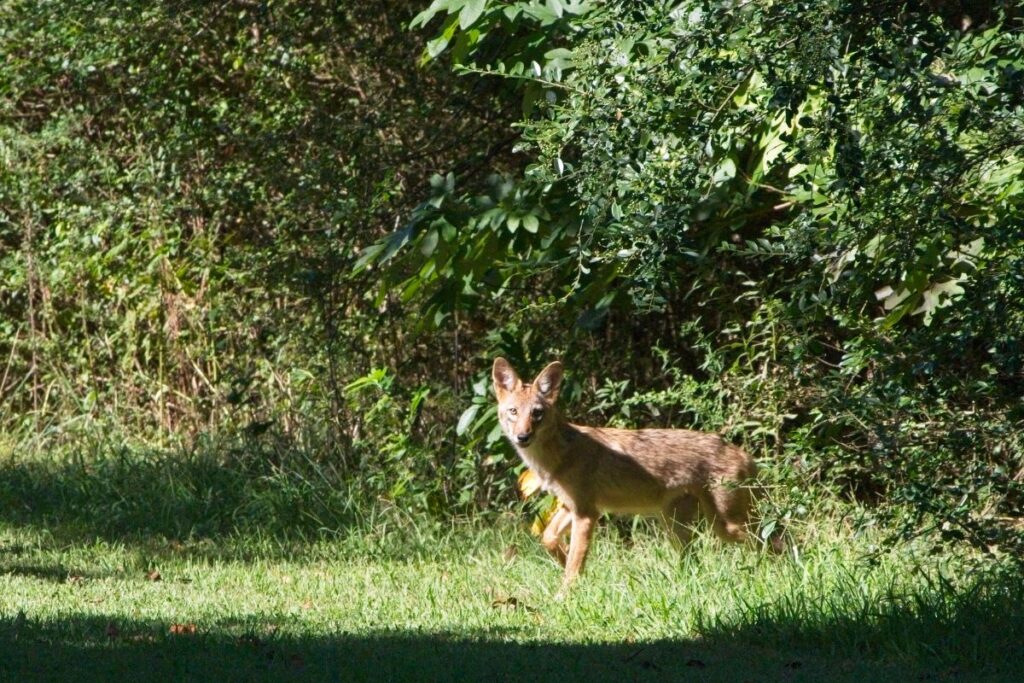
Camping sites such as Oh! Ridge Campground and Silver Lake Campground are known locales where the nocturnal serenades of coyotes can be heard, creating an evocative and unforgettable ambiance under the starry skies.
While they might occasionally venture close to human camps, it’s vital to avoid feeding them and to secure food items.
An engaging tidbit for those charting their Mammoth Lakes expedition: despite their wild nature, coyotes have demonstrated remarkable adaptability, even thriving in urban fringes across North America.
This adaptability showcases their intelligence and resilience. As you immerse yourself in the Mammoth Lakes experience, the sight or sound of a coyote will indelibly etch a memory of the wild, untamed beauty of the region. Always remember to observe with respect, maintaining a safe distance.
Bald eagles
Embodying majesty and freedom, the bald eagle’s powerful presence is a breathtaking spectacle against the panoramic views of Mammoth Lakes.
With their striking white heads, yellow beaks, and impressive wingspans, bald eagles are not just America’s national bird but also an emblem of the wild spirit that thrives in this pristine landscape.
Eagle enthusiasts will find the shores of the larger lakes within Mono Basin National Forest Scenic Area and the dense tree lines of Inyo National Forest as prime spots for sightings.
The June Lake and Lake Mary areas, in particular, provide essential habitats where these raptors often nest and hunt.
For those willing to tread the paths less taken, the Horseshoe Lake Trail and Twin Lakes Overlook present panoramic vistas where the silhouette of a soaring bald eagle against the azure sky is a sight to behold.
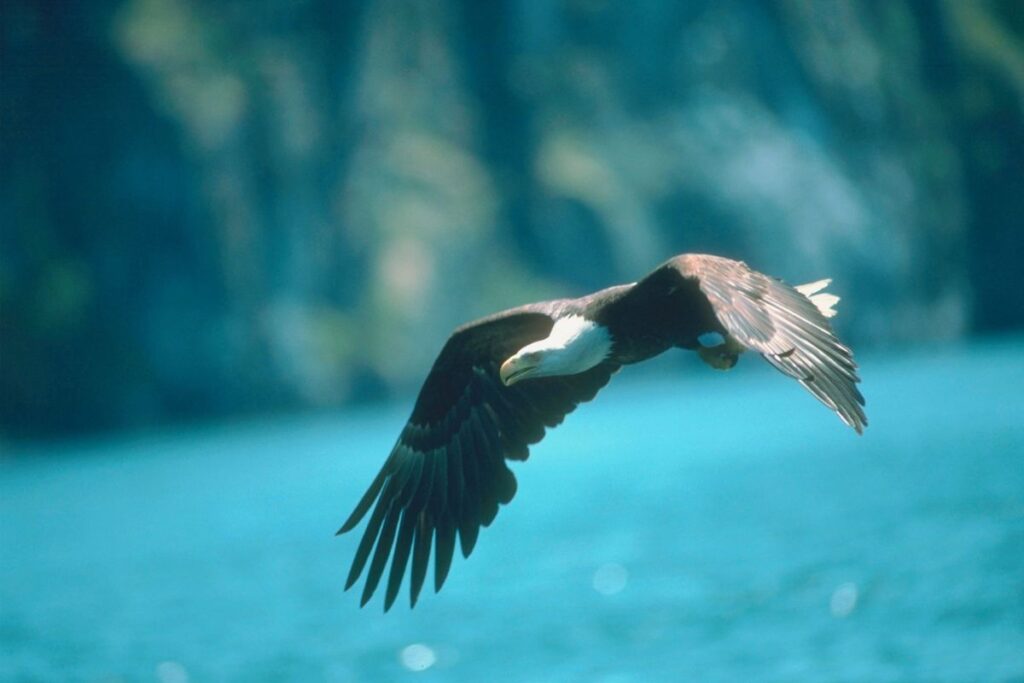
Campgrounds like Lake George Campground and Pine City Campground are strategically positioned near their favored fishing grounds, making them potential spots for witnessing these majestic birds diving for fish or perched regally atop tall trees.
For travelers with an appetite for trivia: despite their formidable appearance, bald eagles have a surprisingly weak voice, often described as kitten-like chirps.
This juxtaposition of might and delicacy encapsulates the many contrasts of Mammoth Lakes’ wilderness. When charting your journey, be sure to pack a good pair of binoculars or a camera with a zoom lens to capture the grandeur of bald eagles from a respectful distance.
Their presence is a reminder of the unspoiled beauty that Mammoth Lakes continues to preserve and cherish.
Ospreys
The osprey, often dubbed the ‘fish hawk,’ is an avian marvel that graces the skies of Mammoth Lakes with its unparalleled fishing prowess.
With piercing eyes, white underbelly, and dark wingtips, the osprey’s aerial acrobatics as it dives to snatch fish from the water is a thrilling spectacle, embodying the raw essence of nature in action.
The pristine waters of Mammoth Lakes, particularly Convict Lake and Crystal Crag Lake, serve as favorite hunting grounds for these skilled raptors.
Trails such as the Convict Lake Loop Trail and Mammoth Lakes Basin Path provide panoramic views of the lakes, where patient observers might be rewarded with the sight of an osprey plummeting talon-first into the water, emerging with a catch.
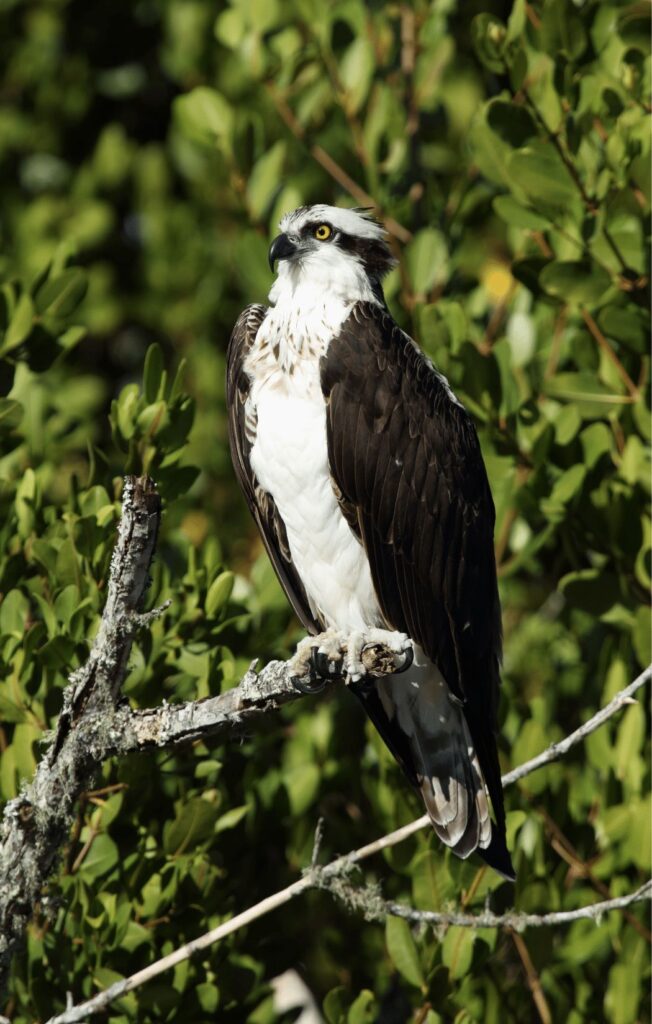
For those opting to camp around the lakes, locations like Lake Mary Campground and Coldwater Creek Campground are idyllic settings that often resonate with the osprey’s distinctive calls, especially during the mornings and evenings when they’re most active in their fishing endeavors.
An interesting snippet for those gearing up for a Mammoth Lakes adventure: Ospreys are one of the few bird species found worldwide, and their diet is almost exclusively fish, showcasing their specialized hunting adaptations.
Their reversible outer toe helps grip fish more effectively, making their catch rate impressively high. As you immerse yourself in the Mammoth Lakes experience, the osprey’s presence adds a dynamic, wild dimension to the serene landscapes.
Always keep an eye skyward and have your camera ready to capture these avian masters in action, while ensuring minimal disturbance to their natural behavior.
Peregrine falcons
Synonymous with speed and agility, the peregrine falcon is a true marvel of the avian world and a splendid sight in the expansive skies of Mammoth Lakes.
Recognized by their sleek, blue-gray plumage and a distinct black hood, these falcons command the skies, often seen in a stoop or dive that can reach astonishing speeds of over 240 mph, making them the fastest animals on Earth.
The craggy cliffs and high elevations of the John Muir Wilderness and parts of Ansel Adams Wilderness are favored nesting spots for these incredible raptors.
For those seeking to witness their unparalleled aerial displays, trails like Minaret Summit and Lookout Mountain Trail are prime vantage points. These areas offer sweeping views of the terrain below, where the falcons often engage in their breathtaking hunting dives.
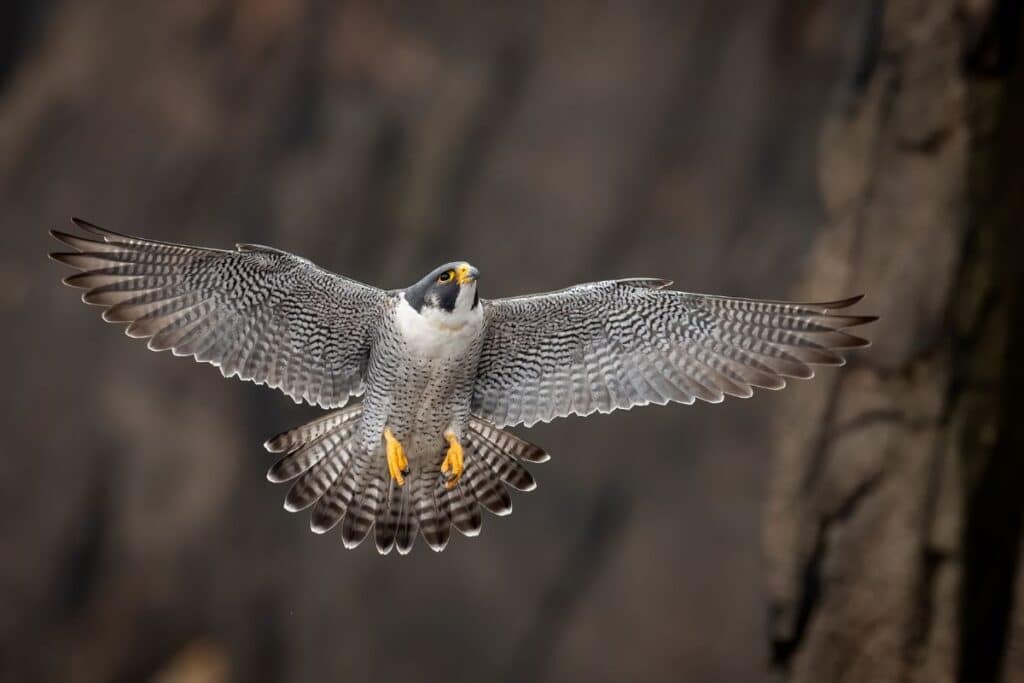
Campsites situated at higher elevations, including Agnew Meadows Campground and Upper Soda Springs Campground, offer potential glimpses of these birds, especially during their active hunting periods in mornings and late afternoons.
A captivating fact for travelers journeying to Mammoth Lakes: The peregrine falcon’s name means “wanderer” or “pilgrim,” apt given their vast migratory routes. Their vision, up to eight times more acute than that of a human, enables them to spot prey from great heights.
When planning your Mammoth Lakes excursion, the potential sighting of a peregrine falcon is a thrilling bonus. Always keep binoculars handy, and respect the falcon’s space, allowing them to hunt and roam undisturbed in their natural habitat.
Western bluebirds
A splash of vibrant color amidst the natural hues of Mammoth Lakes, the Western bluebird captivates with its iridescent blue feathers and warm orange underbelly.
These small, perky songbirds are often seen flitting from branch to branch, singing melodiously, bringing a lively charm to the serene landscapes.
Open woodlands and the edges of meadows in the Inyo National Forest and parts of the Mono Basin National Forest Scenic Area are the ideal environments where these bluebirds thrive.
For birdwatchers and enthusiasts, trails such as Rainbow Falls Trail and Sherwin Lakes Trail offer abundant opportunities to spot and hear these cheerful birds, especially during the early morning when they are most active in their search for insects.
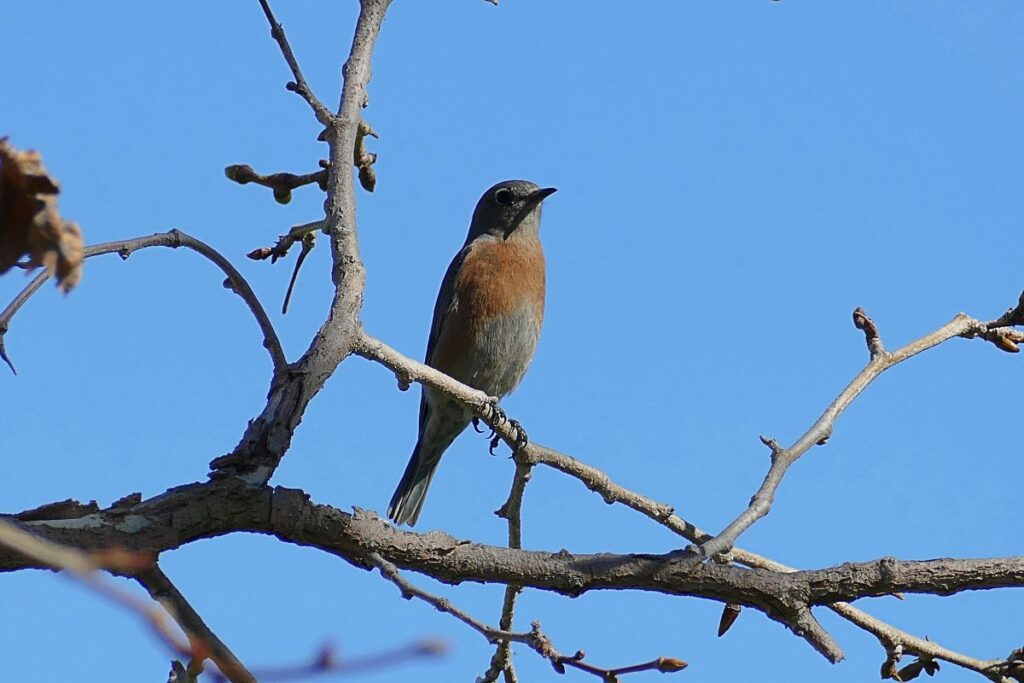
Campers at spots like Twin Lakes Campground and Pumice Flat Campground might be serenaded by the soft, melodious calls of the Western bluebirds, especially during dawn and dusk.
A delightful nugget for nature lovers venturing to Mammoth Lakes: Western bluebirds are cavity-nesting birds. They often seek out old woodpecker holes or natural tree cavities to build their nests, and they’ve also shown a positive response to man-made nest boxes.
Their vibrant colors and sweet songs make them a favorite among birdwatchers. As you traverse the trails and campgrounds of Mammoth Lakes, the presence of the Western bluebird is a heartwarming reminder of nature’s simple joys.
To enhance your birdwatching experience, carry a field guide and a pair of binoculars to appreciate these avian gems up close, yet unobtrusively.
American dippers
Often described as nature’s enchanting aquatic songbird, the American dipper stands out amidst the tranquil settings of Mammoth Lakes. Cloaked in a slate-gray plumage, what these birds lack in vibrant colors, they make up for with their unique behavior.
With their uncanny ability to ‘dip’ and walk underwater, they forage for aquatic insects, small fish, and larvae, offering an unusual spectacle for keen-eyed observers.
The fast-moving, clear streams and waterfalls of Inyo National Forest and cascades in the John Muir Wilderness provide the perfect stage for the dippers’ aquatic ballet.
Trails running alongside water bodies, such as Rush Creek Trail and Parker Lake Trail, are prime locations to catch a glimpse of these birds as they flit from rock to rock and dive into the water.
Campers near water-rich locations like Agnew Meadows Campground and Devils Postpile Campground stand a good chance of spotting, and perhaps even hearing, the American dipper’s distinctive trill, especially in the gentle hush of the early mornings and late afternoons.
A captivating tidbit for those exploring Mammoth Lakes: The American dipper is North America’s only truly aquatic songbird. Their nictitating membrane (a third eyelid) allows them to see underwater, and their unique hemoglobin helps them endure low oxygen levels in high altitudes.
As you immerse yourself in the tranquil surroundings of Mammoth Lakes, the dance of the American dipper on the water’s edge is a poetic experience, reminding visitors of the intricate ballet of life that thrives in every nook and cranny of this region.
To enrich the experience, a quiet approach and a patient watch are recommended.
Sierra Nevada yellow-legged frogs
In the pristine alpine lakes and tranquil streams of Mammoth Lakes, the Sierra Nevada yellow-legged frog makes its delicate presence known. This amphibian, with its distinctive yellowish tinge on the undersides of its legs, is a unique inhabitant of the high-elevation aquatic ecosystems.
Their mottled green and brown dorsal side provides perfect camouflage against the rocky and marshy habitats they frequent.
The clear, cool waters in parts of the Ansel Adams Wilderness and the serene ponds and lakes of John Muir Wilderness are sanctuaries for these frogs. Wetland areas along trails such as Thousand Island Lake Trail and Shadow Lake Trail can be rewarding for travelers keen on observing these elusive amphibians in their native habitat.
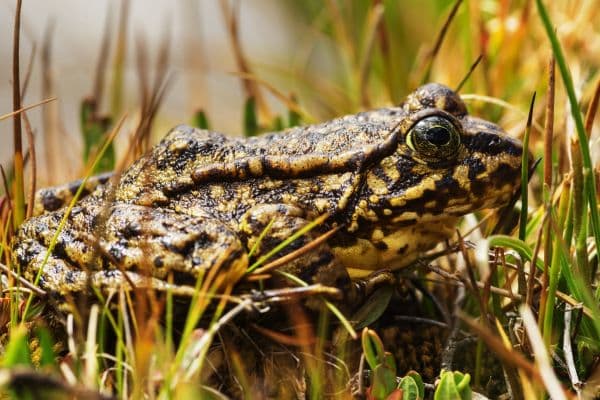
Campers who choose spots like Garnet Lake Campsite or the vicinity of Ediza Lake might chance upon the soft, repetitive croaks of these frogs, particularly during the evening mating calls.
A note of interest for those venturing into Mammoth Lakes: The Sierra Nevada yellow-legged frog has faced significant population declines over the past decades, making them a focal point of conservation efforts in the region.
Their presence indicates a healthy aquatic ecosystem. As you navigate the serene waterscapes of Mammoth Lakes, stumbling upon the Sierra Nevada yellow-legged frog is not just a delightful encounter but also a poignant reminder of nature’s fragility and the importance of conservation.
While observing, ensure minimal disturbance, and tread lightly, cherishing the delicate balance of this alpine ecosystem.
Mountain yellow-legged frogs
Amid the shimmering waters and marshy embankments of Mammoth Lakes, the mountain yellow-legged frog carves a niche for itself.
Characterized by their distinctive yellow-orange undersides and a mottled brownish hue on their backs, these frogs are a delightful representation of the rich amphibian life in the Sierra Nevada region.
Primarily, the untouched waters of Inyo National Forest and the pristine ponds scattered throughout Ansel Adams Wilderness serve as ideal habitats for these amphibians.
For those with a keen interest in herpetology or simply nature enthusiasts, trails encompassing wetlands like Sotcher Lake Nature Trail and Heart Lake Trail can offer the chance to observe these frogs, especially during their active periods in warmer months.
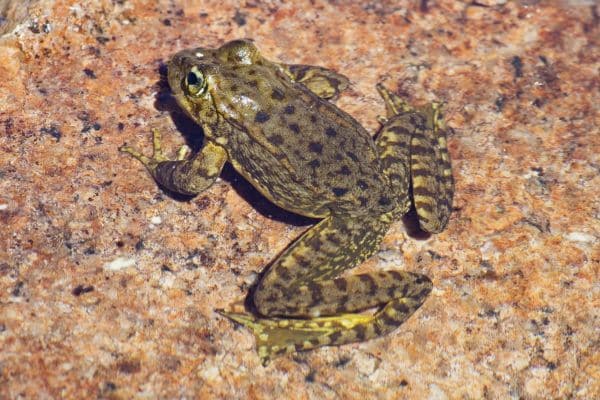
Setting up camp near aquatic sites, especially locations like TJ Lake Campground and areas around Barrett Lakes, might reward you with the gentle croaking of these frogs, often heard during twilight hours as they seek mates or defend their territories.
An enlightening piece of information for those exploring Mammoth Lakes: Much like their close relatives, the Sierra Nevada yellow-legged frogs, the mountain yellow-legged frogs have experienced significant declines, making them a conservation priority in California. Their continued existence underscores the significance of preserving natural habitats and ecosystems.
As you traverse the diverse landscapes of Mammoth Lakes, an encounter with the mountain yellow-legged frog is not just a fascinating experience but also a testament to the intricate web of life in these alpine environs.
Observers are urged to be respectful, ensuring their actions help in sustaining the delicate environments these frogs call home.
Rubber boas
One of the lesser-known but equally fascinating residents of Mammoth Lakes is the rubber boa. With its smooth, velvety skin that feels almost rubbery to the touch and a uniform olive to brown coloration, this snake is a gentle giant of the reptile world in the region.
Their docile nature and unique appearance, with small beady eyes and a blunt tail that almost resembles their head, make them intriguing to those who chance upon them.
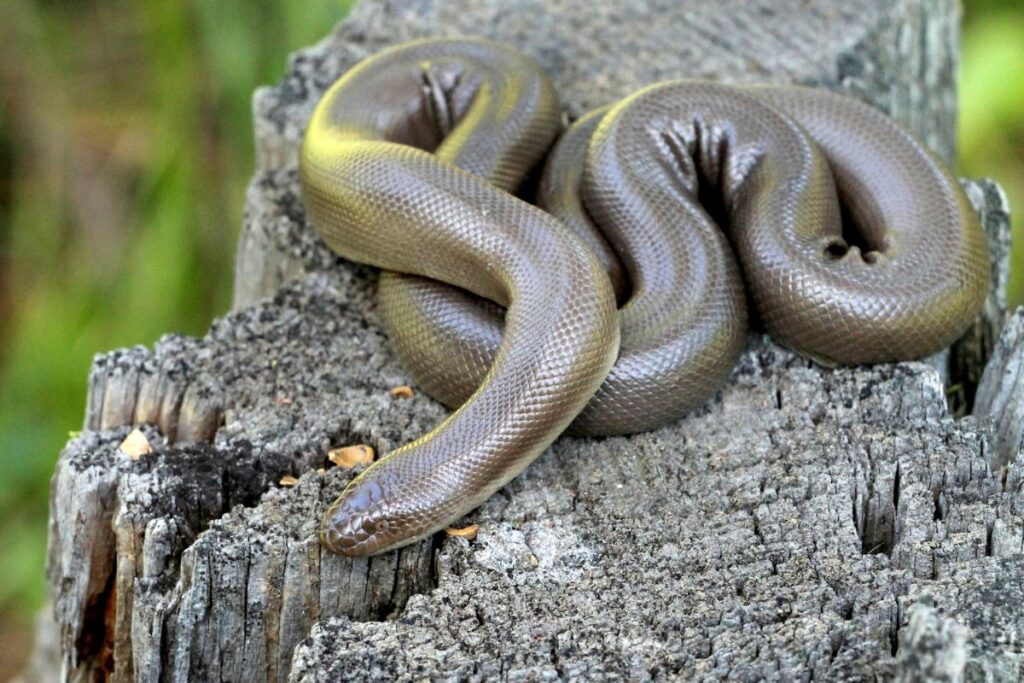
Forests with moist soils, such as those in Inyo National Forest and parts of Mono Basin National Forest Scenic Area, are where these secretive serpents often reside.
Trails that meander through such terrains, like Coldwater Creek Trail and Mammoth Pass Trail, might provide the rare opportunity to spot rubber boas, especially during the dusk when they emerge from their burrows in search of food.
For campers stationed at spots like Reds Meadow Campground and Moraine Campground, a keen eye and a bit of luck might lead to a sighting of this elusive snake, particularly during warmer nights when they are most active.
A fascinating nugget for adventurers in Mammoth Lakes: Despite their seemingly intimidating appearance as snakes, rubber boas are incredibly mild-mannered and are known to rarely, if ever, bite humans. In fact, they have a unique hunting technique, using their tail to distract and confuse their prey.
Encountering a rubber boa during your Mammoth Lakes exploration is a reminder of the diverse and often unexpected wonders the natural world holds. As always, while observing wildlife, it’s essential to maintain a respectful distance, ensuring the boa’s natural behaviors remain undisturbed.
Western fence lizards
Amidst the rocky outcrops and sunlit clearings of Mammoth Lakes, the Western fence lizard, often colloquially dubbed the “blue-belly,” proudly displays its vibrant underbelly in territorial displays.
Recognizable by their spiny, keeled scales and the striking blue patches on their undersides, these lizards are a common sight, often seen basking in the sun or doing push-up-like displays to establish dominance.
The open woodlands and sunny clearings within Inyo National Forest and the rocky terrains of Mono Basin National Forest Scenic Area serve as ideal habitats for these energetic reptiles.
Hiking trails that offer a mix of sun and shade, such as McLeod Lake Trail and Gaylor Lakes Trail, present ample opportunities to observe the dynamic behaviors of these lizards, especially during mid-mornings when they are most active.
Camping spots like New Shady Rest Campground and Pine Glen Campground are places where campers might frequently encounter these lizards scurrying across paths or taking in the warmth on rocks and logs.
An intriguing tidbit for those journeying through Mammoth Lakes: The Western fence lizard’s blood has properties that neutralize the bacteria responsible for Lyme disease. When ticks feed on these lizards and subsequently bite humans, the risk of Lyme disease transmission is significantly reduced.
As you navigate the scenic landscapes of Mammoth Lakes, the sight of a blue-belly lizard basking or displaying is a delightful snapshot of the intricate ecosystem in play.
While they might be approachable, it’s essential to observe without direct handling, ensuring the lizards remain undisturbed in their natural settings.
Tips for responsible wildlife viewing
- Keep a safe distance: Always maintain a respectful distance from wild animals to ensure their safety and yours. Use binoculars or a camera with a zoom lens to get a closer look without disturbing them.
- Never feed wildlife: Feeding wild animals can lead to a dependency on humans, making them more susceptible to harm. Keep all food secured and dispose of trash responsibly.
- Stay on designated trails: To minimize your impact on wildlife and their habitat, stick to established trails when hiking or exploring.
- Be quiet and patient: Noise can stress wildlife and make them more difficult to spot. Keep your voice low and remain patient to increase your chances of successful sightings.
- Educate yourself: Learn about the wildlife you hope to see and familiarize yourself with their habits, habitat, and any local regulations that may apply. This knowledge will help you have a more enjoyable and responsible wildlife viewing experience.
Prime Wilderness Areas in Mammoth Lakes
Ansel Adams Wilderness
The Ansel Adams Wilderness, named in honor of the renowned American photographer and environmentalist, covers over 230,000 acres of stunning landscapes.
With jagged peaks, alpine meadows, and crystal-clear lakes, this unspoiled wilderness is a haven for outdoor enthusiasts, featuring numerous opportunities for hiking, backpacking, and wildlife viewing.
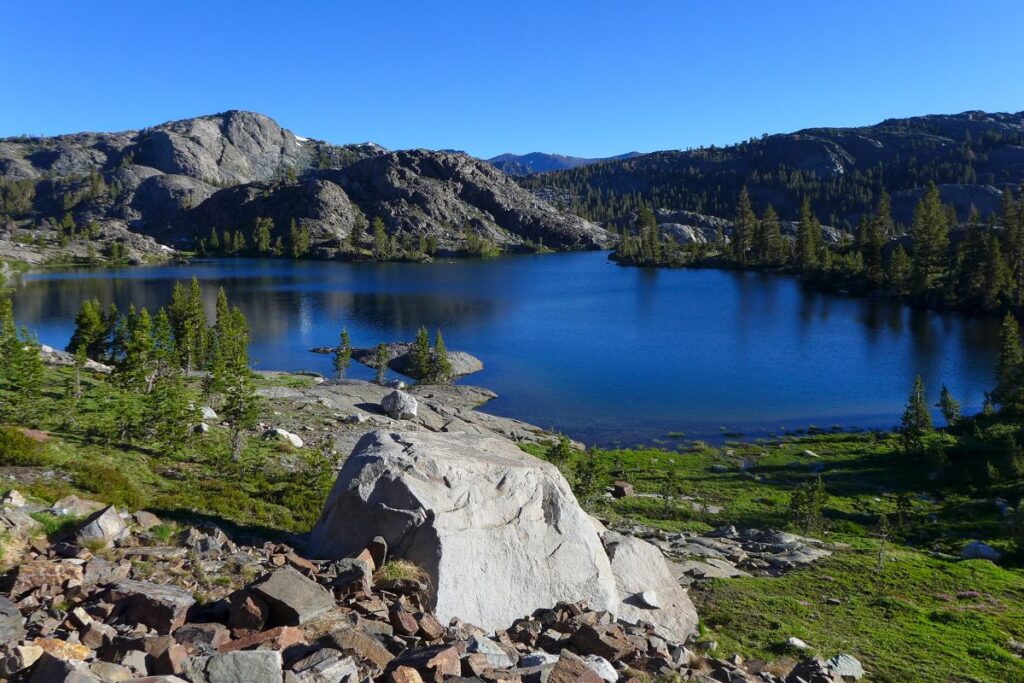
Wildlife species found
An impressive variety of wildlife inhabits the Ansel Adams Wilderness, such as black bears, mule deer, mountain lions, bighorn sheep, and coyotes.
Birdwatchers have the chance to spot bald eagles, ospreys, peregrine falcons, western bluebirds, and American dippers.
Reptile and amphibian enthusiasts can look forward to encounters with Sierra Nevada yellow-legged frogs, mountain yellow-legged frogs, rubber boas, and western fence lizards.
Access points and trails
To enter the Ansel Adams Wilderness, visitors can choose from popular trailheads like Agnew Meadows, Devil’s Postpile, and June Lake Loop.
Among the area’s most picturesque trails are the Shadow Creek Trail, the Pacific Crest Trail, and the John Muir Trail, each providing unique vantage points for observing the region’s diverse wildlife.
John Muir Wilderness
The John Muir Wilderness spans over 650,000 acres of unspoiled wilderness with towering granite peaks, lush meadows, and glistening lakes and streams.
Named after the renowned naturalist and conservationist, this vast area showcases the splendor of untouched nature and provides numerous recreational opportunities for wildlife enthusiasts.
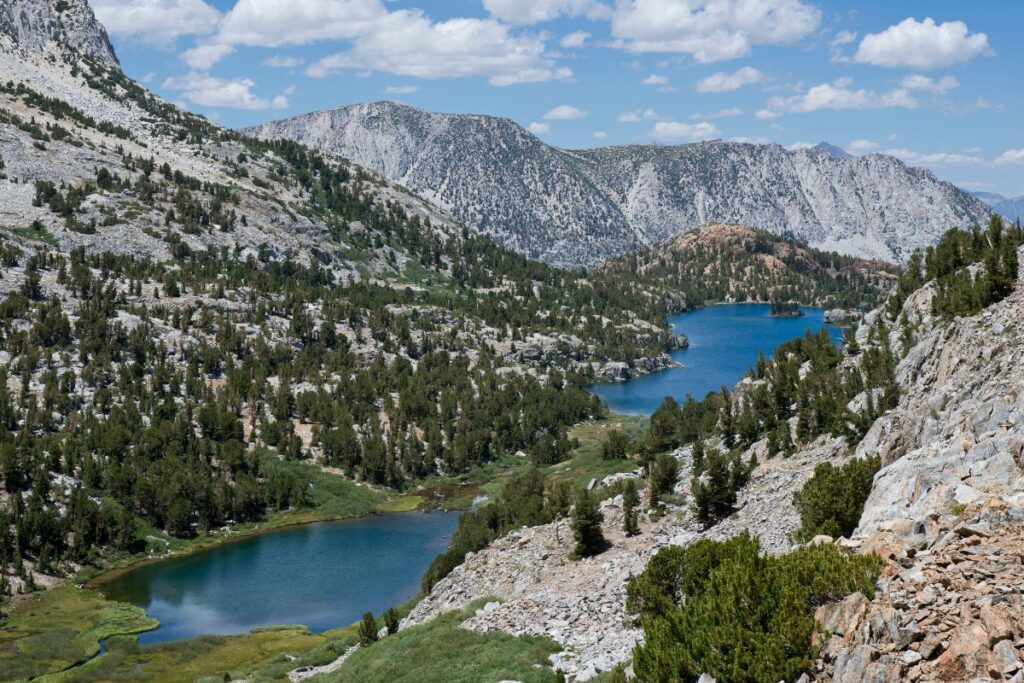
Wildlife species found
A variety of wildlife inhabits the John Muir Wilderness, including stealthy mountain lions and agile mule deer. Bird lovers can anticipate spotting species like bald eagles, ospreys, and peregrine falcons.
The area’s lakes and streams are home to rare amphibians, such as the Sierra Nevada yellow-legged frog and mountain yellow-legged frog, as well as intriguing species like the rubber boa and western fence lizard.
Access points and trails
Visitors can access the John Muir Wilderness through several trailheads, including North Lake, South Lake, and Lake Sabrina.
With trails suited for hikers of all skill levels, options like the Bishop Pass Trail, Mono Pass Trail, and Duck Lake Trail guide visitors into the captivating heart of this untamed landscape.
Inyo National Forest
Covering more than two million acres, the Inyo National Forest is a vast expanse of diverse landscapes, ranging from high desert to alpine forests.
Home to the ancient bristlecone pines, some of the oldest living organisms on Earth, this national forest provides a stunning backdrop for outdoor adventures and wildlife encounters.
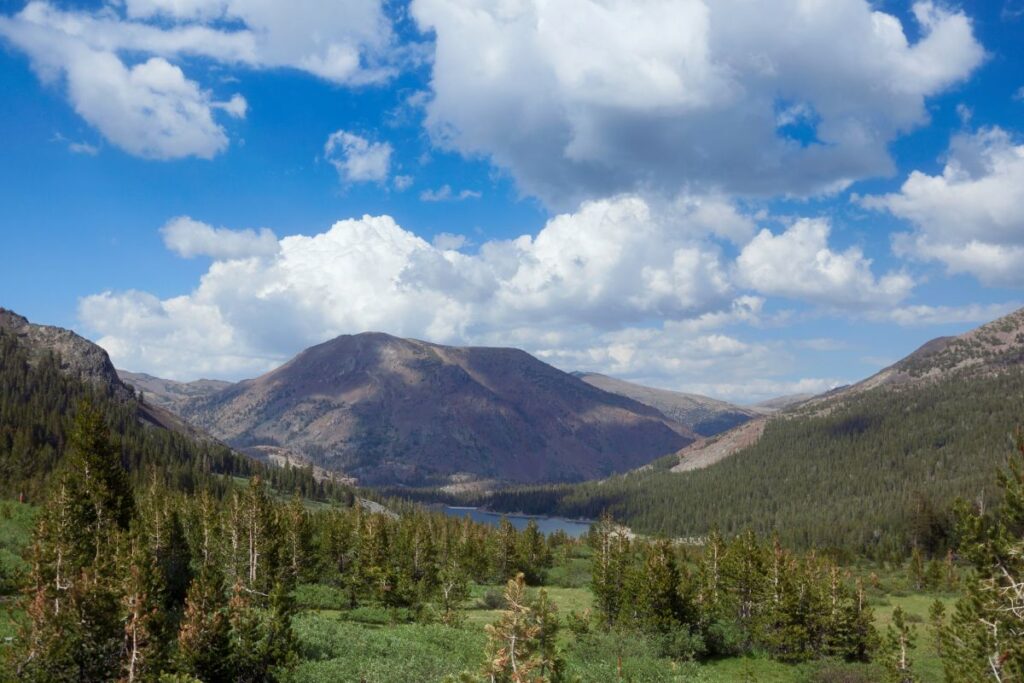
Wildlife species found
The Inyo National Forest is brimming with diverse wildlife, such as black bears, mule deer, mountain lions, coyotes, and bighorn sheep.
For bird enthusiasts, the opportunity to spot bald eagles, ospreys, peregrine falcons, and western bluebirds awaits.
Additionally, nature lovers can discover the region’s fascinating reptiles and amphibians, including the Sierra Nevada yellow-legged frog, mountain yellow-legged frog, rubber boa, and western fence lizard.
Access points and trails
The Inyo National Forest boasts a wide array of trailheads and an extensive trail network, accommodating adventurers of varying skill levels.
Among the popular trails are the Big Pine Lakes Trail, the Little Lakes Valley Trail, and the Ancient Bristlecone Pine Forest Trail.
Each of these trails provides a distinct opportunity for exploring the diverse habitats and observing the abundant wildlife found within the area.
Mono Basin National Forest Scenic Area
The Mono Basin National Forest Scenic Area is a stunning and unique region encompassing over 30,000 acres, centered around the striking Mono Lake.
Known for its otherworldly tufa formations, alkaline waters, and dramatic volcanic landscape, this scenic area is a must-visit for nature lovers and wildlife enthusiasts alike.
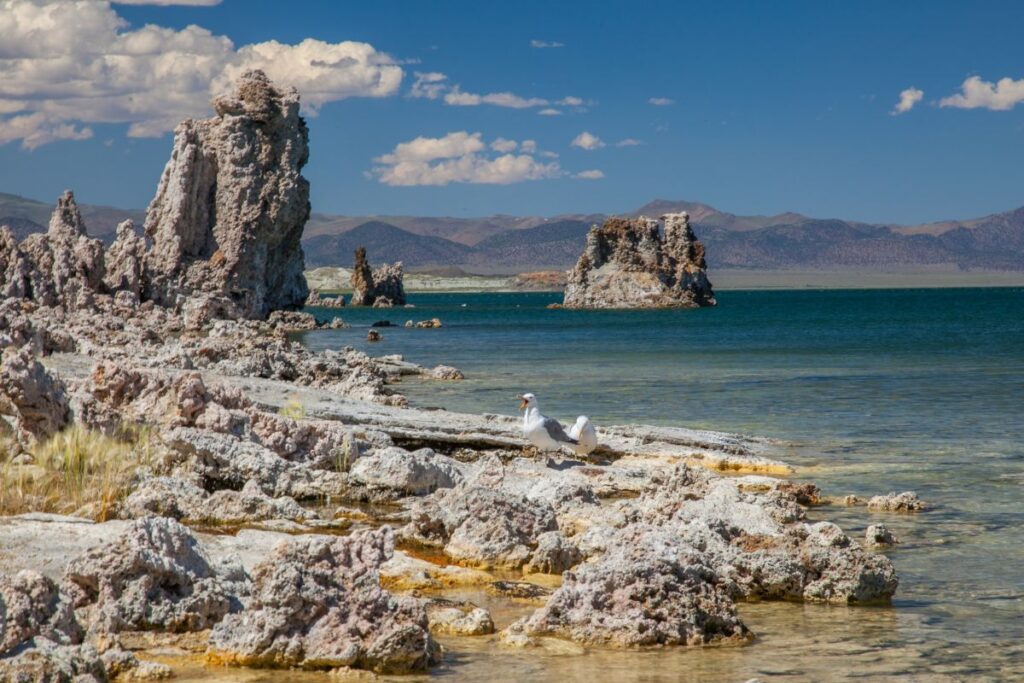
Wildlife species found
The Mono Basin is a vital habitat for a variety of wildlife, especially birds.
The area is famous for its migratory bird populations, including California gulls, eared grebes, and Wilson’s phalaropes.
Other notable bird species in the area include bald eagles, ospreys, and peregrine falcons.
Mammals such as mule deer, coyotes, and pronghorn antelope can also be spotted, while the basin’s unique ecosystem supports species like the western fence lizard and the endangered Sierra Nevada yellow-legged frog.
Access points and trails
The Mono Basin National Forest Scenic Area offers several access points and trails for visitors to explore its unique landscapes and catch a glimpse of its fascinating wildlife.
Some popular trails include the South Tufa Trail, which takes visitors through the area’s iconic tufa formations, the Panum Crater Trail, which offers a closer look at the region’s volcanic past, and the Mono Lake South Shore Trail, providing ample birdwatching opportunities.
Don’t forget to stop by the Mono Basin Scenic Area Visitor Center for more information on trails, guided walks, and wildlife viewing tips.
By exploring these prime wilderness areas in Mammoth Lakes, you’ll have the opportunity to witness the incredible biodiversity and natural beauty that this region has to offer.
Whether you’re an experienced hiker or a casual wildlife enthusiast, Mammoth Lakes has something for everyone, providing unforgettable experiences and cherished memories of the great outdoors.
Conclusion
As we wrap up our journey through Mammoth Lakes’ wild side, let’s take a moment to recap the key points of this ultimate wildlife adventure guide.
We’ve introduced you to the fascinating array of animals and birds that call Mammoth Lakes their home, offering a glimpse into the region’s vibrant ecosystem.
We’ve also shared some of the best hiking trails and prime wilderness spots where you can maximize your chances of unforgettable wildlife encounters, such as the Ansel Adams Wilderness, John Muir Wilderness, Inyo National Forest, and Mono Basin National Forest Scenic Area.
We encourage you to explore the natural wonders of Mammoth Lakes responsibly and with a deep appreciation for the wildlife that inhabits this extraordinary region.
Remember to follow responsible wildlife viewing practices, stay on designated trails, and respect the environment that these incredible creatures call home.
Lastly, we invite you, our fellow wildlife enthusiasts, to share your experiences and sightings from your adventures in Mammoth Lakes.
Your stories will inspire others to embark on their own journey of discovery, fostering a community of nature lovers who appreciate and protect the beauty of the great outdoors.
Now, it’s time to lace up your hiking boots, grab your binoculars, and set out to explore the captivating world of Mammoth Lakes’ diverse and awe-inspiring wildlife.
